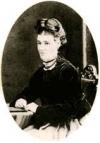Biography
Louisa Lawson (17 February 1848 - 12 August 1920) was an Australian writer, publisher, suffragist, and feminist.
Louisa Lawson was born and raised in Mudgee, New South Wales. The second of 12 children, her family were typical strugglers, and like many girls at that time left school at the age of thirteen. In 1866 she married Niels Larsen (Peter Lawson). Lawson's husband was often absent gold mining or working with his father-in-law, leaving her to raise four children - Henry b 1867, Charles b 1869, Peter b 1873, Annette b 1877 (died at 8 months) and Gertrude b 1877 - on her own. In 1882 she took her children and moved to Sydney. There, Lawson managed boarding houses and saved money that she later used to purchase shares in the radical pro-federation newspaper The Republican in 1887. With her earnings and her experience from working on The Republican, Lawson was able in May 1888, to edit and publish The Dawn.
The Dawn was Australia?s first journal produced solely by women, and was published monthly and distributed throughout Australia and overseas. The Dawn had a strong feminist perspective and frequently addressed issues such as the women's right to vote and assume public office, women's education, women's economic and legal rights, domestic violence, and temperance. The Dawn was published monthly for seventeen years (1888 - 1905) and at its height employed 10 female staff. Lawson's son Henry Lawson also contributed poems and stories for the paper. The Dawn press printed Henry's first book Short Stories in Prose and Verse in 1894.
In 1889 Lawson founded The Dawn Club, which became the hub of the suffrage movement in Sydney. In 1891 the New South Wales Women's Suffrage League formed to campaign for women's suffrage, and Lawson allowed the League to use the Dawn office to print pamphlets and literature free of charge. When women were finally given the vote, in 1902 with the passing of the New South Wales Womanhood Suffrage Bill, Lawson was introduced to the members of Parliament as 'The Mother of Suffrage in New South Wales'. For the women at the time universal suffrage was not the key issue, Lawson did not criticise the government for failing to give Indigenous Australians the vote.
Lawson retired in 1905 but continued to write for Sydney magazines and published The Lonely Crossing and Other Poems, a collection of 52 poems. She died in 1920 aged 72 in Gladesville mental hospital and was buried with her parents at Rookwood cemetery. ..






